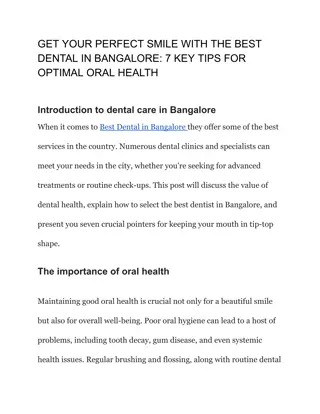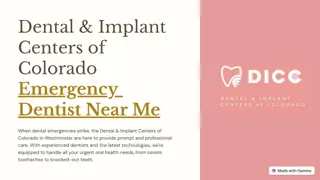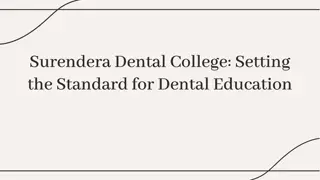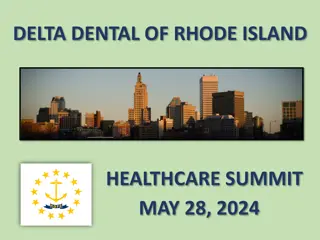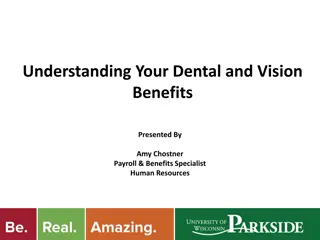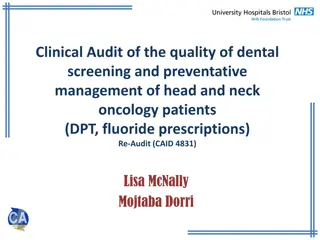Insights into Dental Industry Trends and Practices
Americans spent $122 billion on dental services in 2016, with increased enrollment in Medicaid and private insurance contributing to the rise. Details on dentist earnings, demographics, and patient preferences are highlighted, showing the importance of insurance coverage and location in choosing a dentist. Patient reviews and technology play vital roles in decision-making, with an emphasis on online reputation management. The future of dental practices is predicted to focus on lead generation, online marketing, and consolidation into larger practices.
Download Presentation

Please find below an Image/Link to download the presentation.
The content on the website is provided AS IS for your information and personal use only. It may not be sold, licensed, or shared on other websites without obtaining consent from the author.If you encounter any issues during the download, it is possible that the publisher has removed the file from their server.
You are allowed to download the files provided on this website for personal or commercial use, subject to the condition that they are used lawfully. All files are the property of their respective owners.
The content on the website is provided AS IS for your information and personal use only. It may not be sold, licensed, or shared on other websites without obtaining consent from the author.
E N D
Presentation Transcript
More Americans Are Visiting a Dentist Americans spent $122 billon on dental services during 2016, a 3.4% increase over 2015 s $117.5 billion, which increased 4.4% from 2014, after 2013 s meager increase of just 1.3%. Private insurance paid for almost half (47%), followed by out-of-pocket, 40%, and Medicaid, 10%. Experts attribute the increase in dental spending to increased enrollment in Medicaid and private insurance under the Affordable Care Act. Trends that may help to boost dental spending include the increasing utilization of dental care by working-age adults and children, the expansion of Medicaid dental care optional benefits for adults and generational patterns.
Dental Practice Details The average general-practitioner dentist with a private practice earned $179,960 and specialists $320,460 during 2015. Average gross billings for general-practitioner owner dentists were $647,550 and specialists $1,032,530. The total number of dentists increased 0.37% from 2015 to 2016, or 195,722 and 196,441, respectively. During 2016, the dentist-to- population ratio was 60.8 a slight decrease from 60.9 for 2015. Most US dentists are male (70.2%). The proportion of female dentists has decreased slightly since 2015. More than one-fifth (21.0%) of dentists are specialists. The average retirement age for dentists was 68.8 during 2016, compared to 66.1 for 2015.
Insurance and Location Impact Choice of Dentist In a consumer survey, 59% of respondents said that their decision to use a particular dental practice depended on insurance and 42% said they would switch dentists if the practice stopped accepting their plan. Location was the next most important factor when choosing a dentist, 44%; followed by customer reviews, 29%; use of advanced technology, 19%; dental credentials 18%; and taking immediate appointments, 13%. Of people who avoid going to the dentist, more than half of adults, 59%, say they forego dental care because of cost, 22% because of fear and 19% because they cannot find a convenient location or appointment time.
Understanding the Dental Patient Reviews are critically important; 88% of consumers trust online reviews as much as personal recommendations and 86% are willing to pay more for services with higher ratings and reviews. While 19% said that the use of advanced technology to provide faster and better service was one of the top three factors when choosing a dentist, that number increases to 45% of patients 45 54 and with a household income $50,000 $100,000. Patients referred by other patients have a 37% higher retention rate and are 25% more profitable. Word-of-mouth referrals accounted for half of all purchase decisions.
A Bright White and Shiny Future Dental practices will concentrate more on inbound lead generation marketing, as opposed to general branding. Facebook advertising will also increase, both directly by practices and through aggregators. More practices will use online scheduling tools. Consolidation into large practices with 10 to 20 locations is a continuing trend for economies of scale. Among patients, there will be more discretionary spending, which insurance does not cover. Dentists will save more and improve profitability through 3D printing and group buying.
Advertising Strategies Include the insurance plans you accept in all advertising. Highlight any advanced technology you use in your office. Encourage positive reviews with excellent customer service when booking appointments, and during visits and follow-up appointments.
New Media Strategies Provide an online appointment booking process for busy patients. Ask permission to send patients push notifications via text, including post-visit instructions (no food for 30 minutes, floss daily, etc.) and reminders to book regular appointments every 6 months. Create a branded app for kids for their phone to remind them to brush and floss. When they practice these good dental habits, they enter the details on the app and are then registered to win non-food prizes during their next dentist visit.











